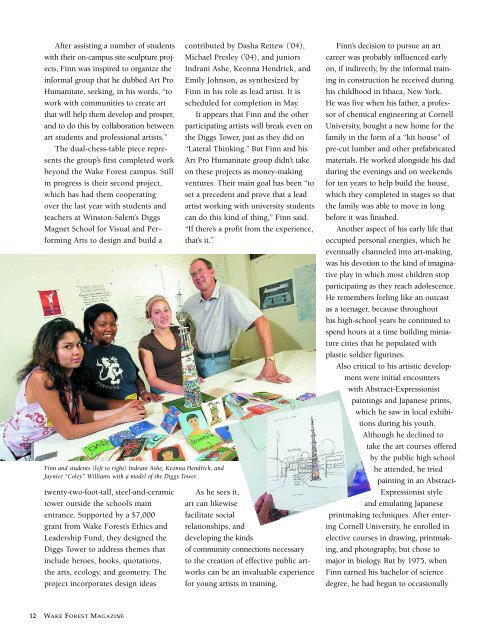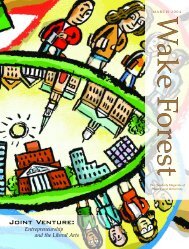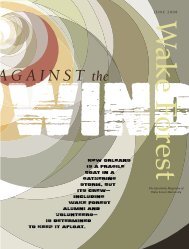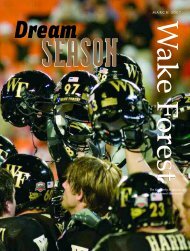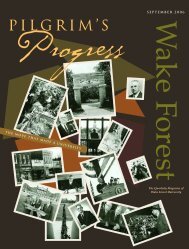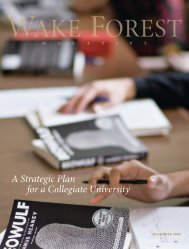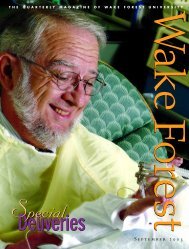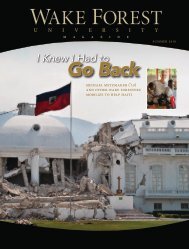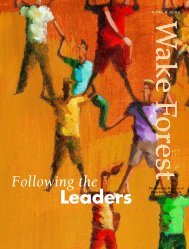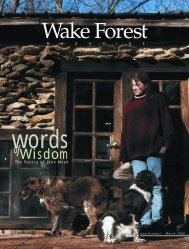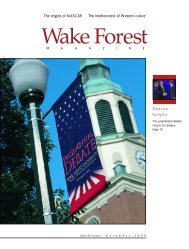Wake Forest Magazine, December 2004 - Past Issues - Wake Forest ...
Wake Forest Magazine, December 2004 - Past Issues - Wake Forest ...
Wake Forest Magazine, December 2004 - Past Issues - Wake Forest ...
Create successful ePaper yourself
Turn your PDF publications into a flip-book with our unique Google optimized e-Paper software.
After assisting a number of students<br />
with their on-campus site-sculpture projects,<br />
Finn was inspired to organize the<br />
informal group that he dubbed Art Pro<br />
Humanitate, seeking, in his words, “to<br />
work with communities to create art<br />
that will help them develop and prosper,<br />
and to do this by collaboration between<br />
art students and professional artists.”<br />
The dual-chess-table piece represents<br />
the group’s first completed work<br />
beyond the <strong>Wake</strong> <strong>Forest</strong> campus. Still<br />
in progress is their second project,<br />
which has had them cooperating<br />
over the last year with students and<br />
teachers at Winston-Salem’s Diggs<br />
Magnet School for Visual and Performing<br />
Arts to design and build a<br />
Finn and students (left to right) Indrani Ashe, Keonna Hendrick, and<br />
Jaynice “Coley” Williams with a model of the Diggs Tower.<br />
twenty-two-foot-tall, steel-and-ceramic<br />
tower outside the school’s main<br />
entrance. Supported by a $7,000<br />
grant from <strong>Wake</strong> <strong>Forest</strong>’s Ethics and<br />
Leadership Fund, they designed the<br />
Diggs Tower to address themes that<br />
include heroes, books, quotations,<br />
the arts, ecology, and geometry. The<br />
project incorporates design ideas<br />
12 WAKE FOREST MAGAZINE<br />
contributed by Dasha Rettew (’04),<br />
Michael Presley (’04), and juniors<br />
Indrani Ashe, Keonna Hendrick, and<br />
Emily Johnson, as synthesized by<br />
Finn in his role as lead artist. It is<br />
scheduled for completion in May.<br />
It appears that Finn and the other<br />
participating artists will break even on<br />
the Diggs Tower, just as they did on<br />
“Lateral Thinking.” But Finn and his<br />
Art Pro Humanitate group didn’t take<br />
on these projects as money-making<br />
ventures. Their main goal has been “to<br />
set a precedent and prove that a lead<br />
artist working with university students<br />
can do this kind of thing,” Finn said.<br />
“If there’s a profit from the experience,<br />
that’s it.”<br />
As he sees it,<br />
art can likewise<br />
facilitate social<br />
relationships, and<br />
developing the kinds<br />
of community connections necessary<br />
to the creation of effective public artworks<br />
can be an invaluable experience<br />
for young artists in training.<br />
Finn’s decision to pursue an art<br />
career was probably influenced early<br />
on, if indirectly, by the informal training<br />
in construction he received during<br />
his childhood in Ithaca, New York.<br />
He was five when his father, a professor<br />
of chemical engineering at Cornell<br />
University, bought a new home for the<br />
family in the form of a “kit house” of<br />
pre-cut lumber and other prefabricated<br />
materials. He worked alongside his dad<br />
during the evenings and on weekends<br />
for ten years to help build the house,<br />
which they completed in stages so that<br />
the family was able to move in long<br />
before it was finished.<br />
Another aspect of his early life that<br />
occupied personal energies, which he<br />
eventually channeled into art-making,<br />
was his devotion to the kind of imaginative<br />
play in which most children stop<br />
participating as they reach adolescence.<br />
He remembers feeling like an outcast<br />
as a teenager, because throughout<br />
his high-school years he continued to<br />
spend hours at a time building miniature<br />
cities that he populated with<br />
plastic soldier figurines.<br />
Also critical to his artistic development<br />
were initial encounters<br />
with Abstract-Expressionist<br />
paintings and Japanese prints,<br />
which he saw in local exhibitions<br />
during his youth.<br />
Although he declined to<br />
take the art courses offered<br />
by the public high school<br />
he attended, he tried<br />
painting in an Abstract-<br />
Expressionist style<br />
and emulating Japanese<br />
printmaking techniques. After entering<br />
Cornell University, he enrolled in<br />
elective courses in drawing, printmaking,<br />
and photography, but chose to<br />
major in biology. But by 1975, when<br />
Finn earned his bachelor of science<br />
degree, he had begun to occasionally


